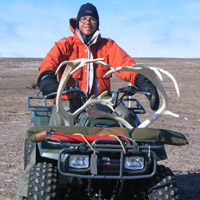
My PhD project is focusing on large scale changes in biodiversity across North America during the Cretaceous and Paleocene. Closely tied to the biodiversity are the effects of climate and productivity of the continent at the time. Previous studies have shown that temperatures worldwide were near a maximum during the Late Cretaceous, with especially pronounced effects in the High Arctic. As well, during much of the time period there existed an epicontinental sea which at times spanned from the Arctic Ocean to the Gulf of Mexico, helping to keep temperatures more stable with less yearly variation and increasing precipitation. This more favorable environment led to the development of lush forests at the High Arctic, but with somewhat unknown characteristics, as the region also experienced periods of prolonged darkness. There is currently no analogue for this type of environment in the world today, but if current trends in global warming were to continue for several million years, the conditions may return. To understand what may happen, we must look to the fossil record for answers. My project is cataloguing all the known floral localities from the Cretaceous and Paleocene to try and build a broad scale understanding of the trends and that had existed and may again come to pass.
For those of you interested in palaeoecology and spatial statistics, I have written a small package for R called fossil. It contains functions for estimating species richness, beta diversity, and mapping functions. The file can be found on CRAN (Comprehensive R Archive Network) at http://cran.r-project.org/web/packages/fossil/index.html.
Office: Room 304, Redpath Museum
Email: matthew.vavrek![]() mail.mcgill.ca
mail.mcgill.ca
Homepage: http://matthewvavrek.com
Phone: (514) 398-4086 ext 00221
Fax: (514) 398-3185
